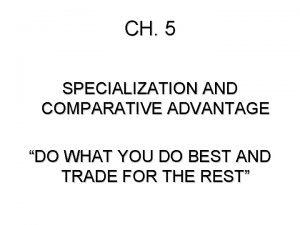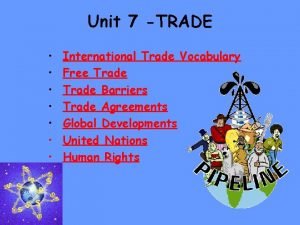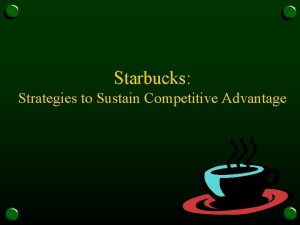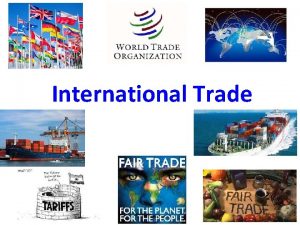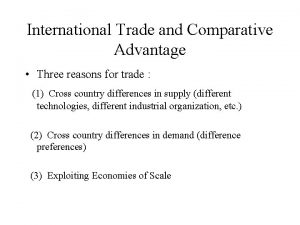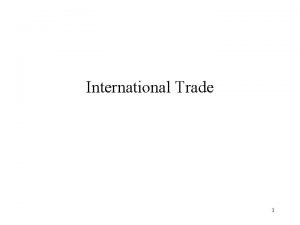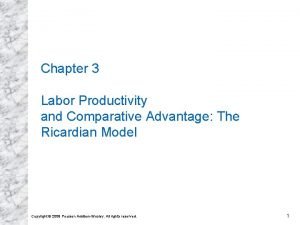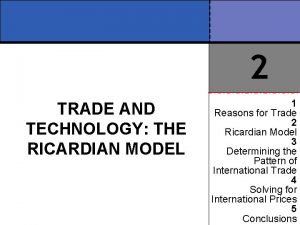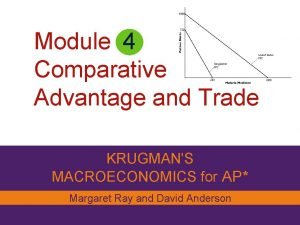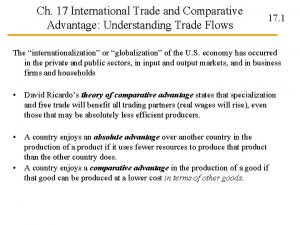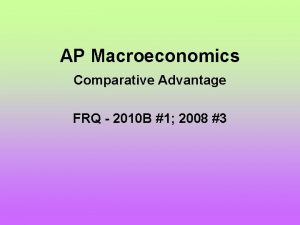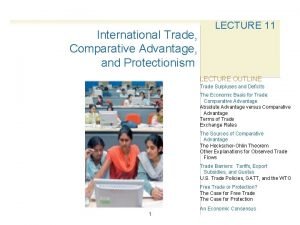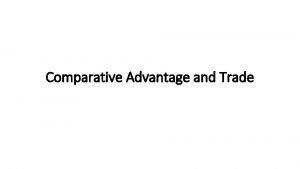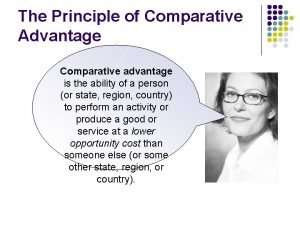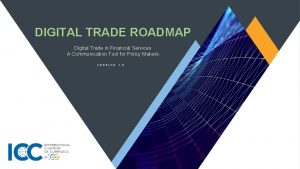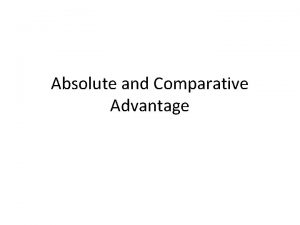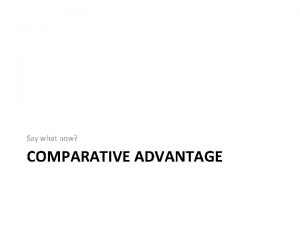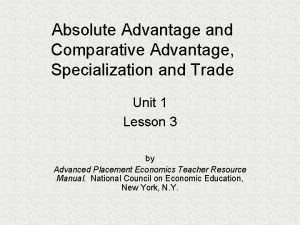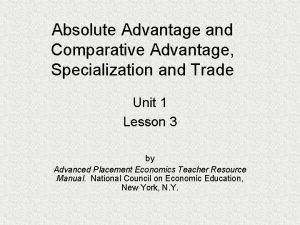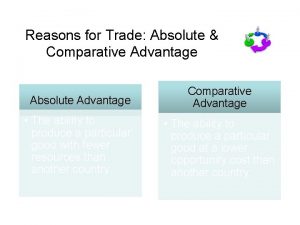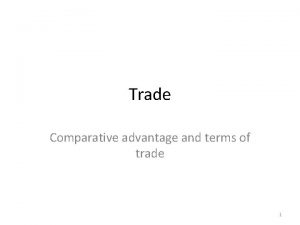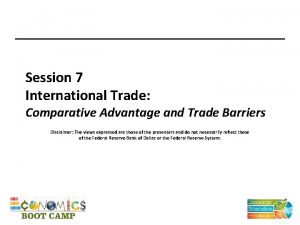Comparative Advantage and Digital Trade Alan V Deardorff



































- Slides: 35

Comparative Advantage and Digital Trade Alan V. Deardorff University of Michigan For presentation at International Trade, New Technologies and International Organization of Production ITSG – Italian Trade Study Group, Politecnico di Milano May 17, 2019 www. fordschool. umich. edu

The Law of Comparative Advantage • Ricardo’s Law of Comparative Advantage – Formulated for a world where all trade was in goods, produced within countries, then transported between countries – Two purposes • To explain the pattern of trade • To illuminate the gains from trade 2 www. fordschool. umich. edu

The Law of Comparative Advantage • Statement of the first purpose, to explain trade: • Trade if not distorted is based on countries’ relative costs of production • Since costs may change with trade, best understood with autarky costs (and autarky prices) 3 www. fordschool. umich. edu

The Law of Comparative Advantage • Theoretical developments – First explained with just two goods, two countries, and only one factor, labor – Extended to more of each, though with limitations • Chain of comparative advantage • Heckscher-Ohlin model 4 www. fordschool. umich. edu

The Law of Comparative Advantage • Theoretical developments – Generality of C-A • In general predictions for every pair of goods/countries not possible • But C-A does hold on average across goods and countries, as correlation – By Dixit and Norman (1980) – By Deardorff (1980) • This was shown to hold for 5 – Arbitrary numbers of goods, factors, and countries – Intermediate inputs – Trade costs www. fordschool. umich. edu

Services • Services – Not initially regarded as trade • Changed by Harry Freeman – Deardorff (1985) • Prompted by my mentor and co-author Bob Stern • Asked whether C-A applies to services trade 6 www. fordschool. umich. edu

Services • Services – Modes 1. 2. 3. 4. Cross-border supply Consumer movement Producer presence Movement of natural persons – I also considered “trade services” • Services such as transport that are complementary to trade • Their providers do follow C-A 7 www. fordschool. umich. edu

Services • Cross-border supply of services – This poses a problem for C-A – Uses factors from both countries – Autarky prices may show high costs in both, but low when combined – So autarky prices mislead for trade 8 www. fordschool. umich. edu

Digital Trade • This brings me to the question of the latest form of trade: Digital Trade • I was asked by Simon Evenett to address this as I had for services: Does the Law of Comparative Advantage hold for digital trade? • Here (and in Deardorff (2017)) I talk through this question for five forms of digital trade that I’ve been able to think of. 9 – “Comparative Advantage in Digital Trade, ” in Simon Evenett, ed. , Cloth for Wine? The Relevance of Ricardo’s Comparative Advantage in the 21 st Century CEPR Press, Center for Economic Policy Research, 2017, pp. 35 -44. www. fordschool. umich. edu

Outline • Five kinds of digital trade – – – Physical products Digital product transmitted digitally Services provided by digital means Storage and applications on The Cloud Online platforms supported by advertising • Conclusion 10 www. fordschool. umich. edu

Digital Trade • Definition – USITC (2013) • “There is no standard or generally accepted definition for ‘digital trade. ’ “ • “the delivery of products and services over either fixed-line or wireless digital networks” – USITC (2014) • “defines digital trade as U. S. domestic commerce and international trade in which the Internet and Internet-based technologies play a particularly significant role in ordering, producing, or delivering products and services” 11 www. fordschool. umich. edu

Digital Trade • My Definition – International commerce for which • the product itself is digital – and/or any of the following are done via the internet or a other digital technology: • • • 12 advertising ordering delivering payment servicing www. fordschool. umich. edu

13 Source: Fefer et al. (2018) www. fordschool. umich. edu

Digital Trade • I’ll look at five kinds of trade: 1. 2. 3. 4. 5. 14 Physical products advertised, ordered, and/or paid for digitally, but transported by normal trade means Digital products (music, movies, books, software) that are transmitted to purchasers via the internet Services that are provided remotely by digital means Data storage and computer applications accessible in “the cloud” Web platforms that serve an international audience and are supported by advertising www. fordschool. umich. edu

Digital Trade • I’ll not look at – The “dark web, ” which apparently may do much of the above, but invisibly and illegally. – Cryptocurrencies, such as bitcoin. – The physical infrastructure of the internet, such as the trans-oceanic fiber-optic cables that transmit the signals and are owned by companies that charge internet service providers for their use. – Other? 15 www. fordschool. umich. edu

1. Physical Products • Become part of digital trade when advertised, ordered, and/or paid for digitally – Example: Amazon, in US takes order from Canada for a good produced in China – C-A? • Production still reflects C-A of China • Amazon is providing a “trade service” based on US C-A 16 www. fordschool. umich. edu

2. Digital products transmitted digitally • Examples – Music – Text (books, etc. ) – Video (movies, TV programs) – Computer programs 17 www. fordschool. umich. edu

2. Digital products transmitted digitally • Distinctive feature – Zero marginal cost • Of both production and transmission – Positive fixed cost 18 www. fordschool. umich. edu

2. Digital products transmitted digitally • C-A? – Doesn’t fit Ricardian Model – Model’s without perfect competition can still conform to C-A • Krugman (1981) (though he didn’t mention this) • I don’t know how general this may be 19 www. fordschool. umich. edu

3. Services provided by digital means • Examples – Programmers taking assignments and delivering results over internet – Computer service provided with remote control of a computer – X-Rays read remotely – Manufacturer that builds in facility for remote monitoring and control 20 www. fordschool. umich. edu

3. Services provided by digital means • C-A? – Cost of service depends on wages and other factor prices where service originates. – Thus does reflect C-A. 21 www. fordschool. umich. edu

4. Storage and applications on the cloud • Remote computing is not new – Bob Stern and I used a mainframe computer that we never saw • But now clusters of servers hold – Data that can be processed remotely – Programs that can be run remotely • Called “the cloud” 22 www. fordschool. umich. edu

23 www. fordschool. umich. edu

4. Storage and applications on the cloud • Top Cloud Companies 2019: – Alibaba. – Amazon Web Services. – Google Cloud Platform. – IBM Cloud. – Microsoft Azure. – Oracle Cloud. 24 Source: Datamation www. fordschool. umich. edu

25 Source: Datamation www. fordschool. umich. edu

4. Storage and applications on the cloud • C-A – Servers require • Human and physical capital • Energy for processing and cooling – Each can be in a different place, based on costs 26 www. fordschool. umich. edu

4. Storage and applications on the cloud • C-A – Like my case above of “cross-border services, none these places may have relatively low cost, and thus C-A, by itself – Indeed, it is ambiguous and thus arbitrary which location is said to be “exporting” the cloud service. 27 www. fordschool. umich. edu

4. Storage and applications on the cloud • C-A – Costs are crucial, but C-A is not helpful for explaining this form of digital trade 28 www. fordschool. umich. edu

5. Online platforms supported by advertising • Examples – Facebook • Instagram • Whats. App – Google • You. Tube – Twitter 29 Source: Dragon Social • Examples – We. Chat • (We. Chat) – Baidu • Toudou Youku – Sina Weibo www. fordschool. umich. edu

5. Online platforms supported by advertising • What they provide – Platform for entertainment and communication • What they produce – Their users’ attention • What they sell – Advertising 30 www. fordschool. umich. edu

5. Online platforms supported by advertising • Is this trade? – Yes, if provider and advertiser are in different countries • C-A? – Costs of providers are conventional: human and physical capital – But also networks 31 www. fordschool. umich. edu

5. Online platforms supported by advertising • C-A? – Success depends also on “network effects” • A successful provider may have higher costs than others, if their history captured the network first • Network success may depend on market size 32 – Hence advantages for US and China – Not S Korea, Finland www. fordschool. umich. edu

5. Online platforms supported by advertising • C-A? – Given the network, profit might be increased by move to where costs are lower • But this need not be in one place • Same problem as for the cloud 33 www. fordschool. umich. edu

Conclusion • Is comparative advantage useful for explaining digital trade? 34 – Yes for some, but not for others – Cloud services may harness costs from more than one country, in each of which autarky costs might be high – Platforms depend on network effects that depend more on country size than costs www. fordschool. umich. edu

Thank you. Questions? 35 www. fordschool. umich. edu
 Comparative advantage ppf
Comparative advantage ppf Duane deardorff
Duane deardorff Deardorff model
Deardorff model Elizabeth deardorff
Elizabeth deardorff Actual mechanical advantage vs ideal mechanical advantage
Actual mechanical advantage vs ideal mechanical advantage Trade diversion and trade creation
Trade diversion and trade creation Trade diversion and trade creation
Trade diversion and trade creation Trade diversion and trade creation
Trade diversion and trade creation Trade diversion and trade creation
Trade diversion and trade creation Tramp shipping and liner shipping
Tramp shipping and liner shipping Specialization and comparative advantage
Specialization and comparative advantage When discussing comparative and absolute advantage
When discussing comparative and absolute advantage Disadvantages of digital photography
Disadvantages of digital photography The trade in the trade-to-gdp ratio
The trade in the trade-to-gdp ratio Fair trade not free trade
Fair trade not free trade Triangular trade
Triangular trade Qatar karta
Qatar karta Competitive strategy of starbucks
Competitive strategy of starbucks Comparative advantage calculation example
Comparative advantage calculation example How to calculate comparative advantage
How to calculate comparative advantage Gains from trade
Gains from trade Comparative advantage example
Comparative advantage example How to calculate comparative advantage
How to calculate comparative advantage Comparative advantage persuasive speech
Comparative advantage persuasive speech Comparative advantage numerical example
Comparative advantage numerical example Determining comparative advantage output method
Determining comparative advantage output method How to calculate comparative advantage
How to calculate comparative advantage Comparative advantage
Comparative advantage Activity 26.5 specialization and trade answers
Activity 26.5 specialization and trade answers Calculating comparative advantage
Calculating comparative advantage Ap macroeconomics frq 2010
Ap macroeconomics frq 2010 Protectionism definition economics
Protectionism definition economics Apple comparative advantage
Apple comparative advantage Comparative advantage example
Comparative advantage example How to find comparative advantage
How to find comparative advantage Digital finance roadmap
Digital finance roadmap










